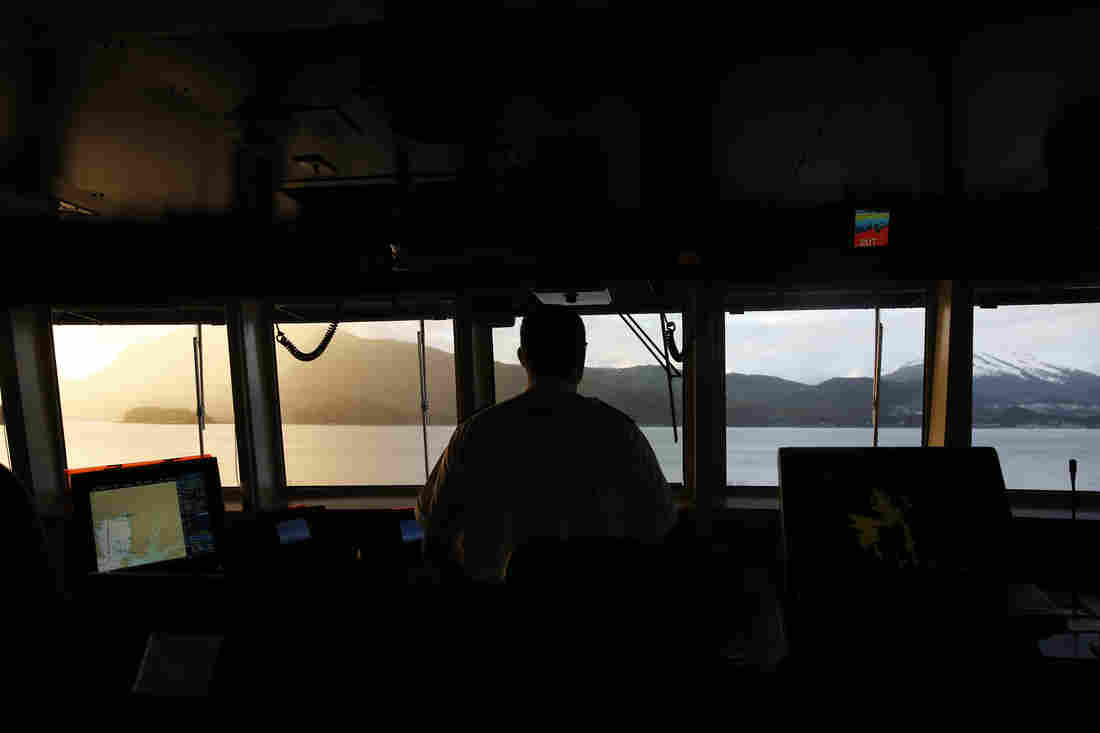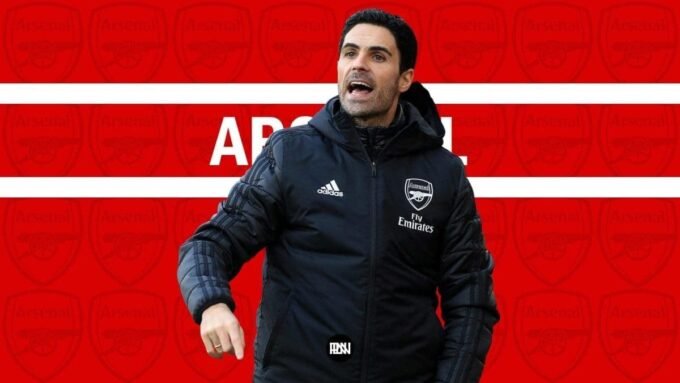
First Mate Aaron Isenhour steers the MV LeConte, a ferry heading from Haines, Alaska to the state capital, Juneau. Elissa Nadworny/NPR hide caption
toggle caption
Elissa Nadworny/NPR
First Mate Aaron Isenhour steers the MV LeConte, a ferry heading from Haines, Alaska to the state capital, Juneau.
Elissa Nadworny/NPR
Southeast Alaska is known as the Panhandle:
It’s a long, narrow strip of mainland coastline, plus 1,000 islands and the braided waterways that surround them.
In most places, there are no roads connecting the communities there, so Alaskans depend heavily on ferries: the Alaska Marine Highway System.
The ferries connect 35 communities in all, and not just in the southeast: The routes stretch for 3,500 miles, from Bellingham, Wash., in the south, all the way to Dutch Harbor, Alaska in the west, far out on the Aleutian Island chain.
In Southeast Alaska, the ferry route runs through the Inside Passage, a spectacular landscape of forest, mountains and fjords.
And that’s what we’ll get to see as we hop on the MV LeConte in Haines, heading for the state capital, Juneau. It will be a 4½ hour trip down the Lynn Canal, traveling at “schoolbus speed,” as our Captain Brian Flory puts it: 15 knots, or about 18 miles per hour.

The MV LeConte heading into Haines. The Alaska Marine Highway is how many people in Southeast Alaska get from town to town. Elissa Nadworny/NPR hide caption
toggle caption
Elissa Nadworny/NPR
We get a prime vantage point up on the bridge with Captain Flory and his crew. As we head southeast from Haines, we pass by a colony of sea lions that have hauled out on rocks in a lumpy brown mass.
Flory has been known to stop the vessel for something amazing, like the time there were over 200 humpback whales within view.
“That was during the early morning hours,” Flory recalls, “and we woke the passengers up for that. You run the danger of someone who doesn’t want to get woken up at 3 or 4 o’clock to look at whales, but I figured it was important enough, because it was such an unusual sighting of so many.”
As we sail, Flory and First Mate Aaron Isenhour scan the route through binoculars, looking for any smaller vessels we need to avoid.

The shop travels at “schoolbus speed,” as our Captain Brian Flory puts it: 15 knots, or about 18 miles per hour. Elissa Nadworny/NPR hide caption
toggle caption
Elissa Nadworny/NPR
This unique system is the only marine route to be designated a National Scenic Byway and All-American Road by the U.S. Department of Transportation.
It is called a marine highway, after all, and that nomenclature is deliberate, Capt. Flory says: “The name, the Marine Highway System, is to try and jog people into thinking that it’s not just a ferry on a back and forth, 10-minute run all day and night. We basically provide the moving highway as the deck of the ship.”
The ferries are a vital link for these tiny communities, who rely on them to bring everything from construction materials to a mobile mammogram van.
“This is what delivers the groceries,” explains passenger Wyatt Rhea-Fournier, who depends on the ferry to get him between Juneau — his hometown — and Haines, where he’s just moved for a new job w the Alaska Department of Fish and Game. He and his girlfriend (and their dog) have taken many rides recently, slowly moving their lives up north. “We don’t have Costcos and Fred Meyers and anything in bulk, so everything is coming up and down here on the Inside Passage. This is our major artery.”
For the smallest communities, especially, “we are their lifeline,” says the ship’s purser, Mary Dahle. She started working on the ferries in 1981, a job that allowed her to put herself through college, and over the decades she’s come to know her passengers well.

Mary Dahle, the purser for the MV LeConte, started working on the ferries in 1981, a job that allowed her to put herself through college. Elissa Nadworny/NPR hide caption
toggle caption
Elissa Nadworny/NPR
She’ll often welcome on board pregnant women from tiny villages, who are heading to the hospital in Juneau to have their babies. She’ll be there to greet them when they head back, too.
“Every week we take a newborn baby home for the first time,” Dahle says. “Last week we took a grandma from Haines down to Angoon to see a grandbaby she hadn’t seen yet. And she spent a week there, and we just delivered her home this morning to Haines.”
Dahle continues, “We get to see everything from babies coming home for the first time, to – we bring the caskets of the elders back to the villages to be buried. So we are part of the community’s life. We are part of that fabric.”

Top: Passengers on the heated deck. Bottom: Purser Mary Dahle poses for a portrait. Elissa Nadworny/NPR hide caption
toggle caption
Elissa Nadworny/NPR
Our trip from Haines to Juneau is a relatively short one, but some of the southeast runs are well over 24 hours. You’ll get on in Ketchikan at 1 pm and get off in Skagway at 6 pm the next day.
School sports teams in Southeast Alaska do this all the time to get to games hundreds of miles away.
The kids pile on the ferry and spread sleeping bags out on the deck floor. “It’s a big slumber party,” Dahle says.
A few days later, games over, they do it all again in reverse.

“The name, the Marine Highway System, is to try and jog people into thinking that it’s not just a ferry on a back and forth, 10-minute run all day and night,” explains Captain Brian Flory. “We basically provide the moving highway as the deck of the ship.” Elissa Nadworny/NPR hide caption
toggle caption
Elissa Nadworny/NPR
Capt. Flory tells me he had 260 kids on the ferry recently, heading to a music festival in Sitka.
I imagine there must have been a wild cacophony of music on deck, but Flory says, no: “We might even have said, ‘leave your instruments downstairs.’ You know, like ‘check your guns at the door!’ ‘All trumpets left down on the car deck!’ But they were a very well-behaved group, so it was kind of fun.”
Purser Mary Dahle says you never know what you’ll see on the ferry. It might be a passenger hauling a washing machine or a rocking chair back home. Or it might be the wedding party she remembers clearly: “Everybody had a dog, and we had 36 dog kennels on the car deck, going to a wedding in Tenakee.”

We get a prime vantage point up on the bridge — where the captain, first mate and able seaman command the ship. Right: Sarah Roark on lookout duty. Left: Aaron Isenhour sets the course. Elissa Nadworny/NPR hide caption
toggle caption
Elissa Nadworny/NPR
Lately, the Marine Highway System has been hit hard by state budget cuts, losing nearly 30 percent of its state funding over the last four years.
Alaska has a state budget deficit of nearly three billion dollars, due to low oil prices and declining oil production.
As a result, ferries have been taken out of operation, service and port calls have been cut, and staff have been laid off.
“Budget cuts are a scary thing,” Dahle says, “because we have been running at a pretty minimal schedule for communities to thrive, or survive, for a number of years. If you go to communities less, it’s like closing down a highway for four days out of the week.”

Captain Brian Flory poses for a portrait on the MV LeConte. Elissa Nadworny/NPR hide caption
toggle caption
Elissa Nadworny/NPR
Privatizing the system is not an option, according to Capt. Flory. “The normal American model is, commercial enterprise can do that,” he says. “Well, the reason we’re doing it is commercial enterprise can’t do it and make a profit. These aren’t necessarily profit-making operations. They’re more like an essential public service.”
For example, Pelican, Alaska – population under 100 – gets ferry service to Juneau once a month, year round. It’s easy to imagine a private company deciding that stop just isn’t worth the money.
As we approach Juneau, I step outside onto the ferry’s rear deck, where the American flag is snapping in a stiff wind. The view off the back of the ship is wild and gorgeous. Then I turn toward the bow. A brilliant rainbow arcs over the ferry, extending from shore to shore.

Catie Reed and Adam Summerfield in the solarium. Elissa Nadworny/NPR hide caption
toggle caption
Elissa Nadworny/NPR
As if that’s not enough, passenger Phyllis Sage has spotted something else: “It was a whale! He just came up by the rainbow arch.”
Disappointed, I tell her that I missed it. “Well, you were looking up,” Sage says, with a laugh. “It’s a beautiful rainbow.”
Suddenly, she exclaims, “Oh! Double! Double rainbow! Lookit, double!”
It’s true. We have not one but two rainbows welcoming us to Juneau. You couldn’t ask for a better finish.
The “Our Land” series is produced by Elissa Nadworny.

The ferry docks at Auke Bay Ferry Terminal in Juneau. Elissa Nadworny/NPR hide caption
toggle caption
Elissa Nadworny/NPR
The ferry docks at Auke Bay Ferry Terminal in Juneau.
Elissa Nadworny/NPR














Leave a comment